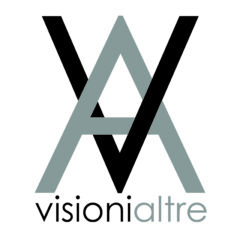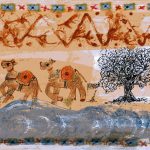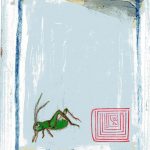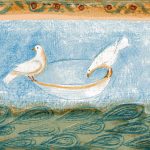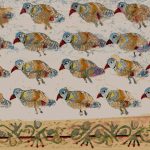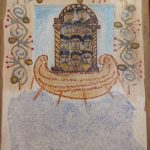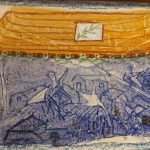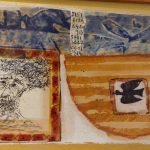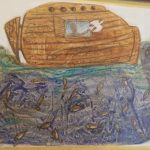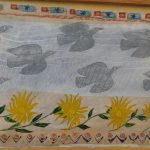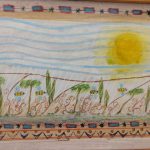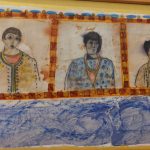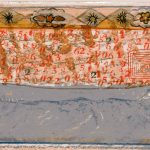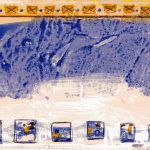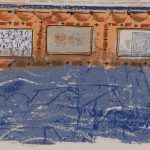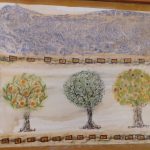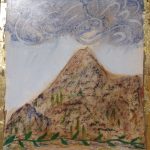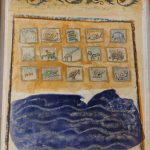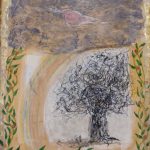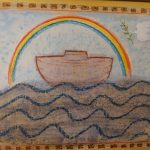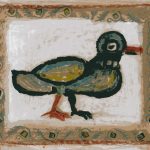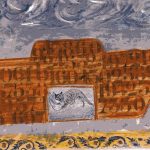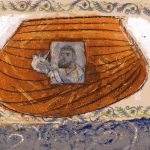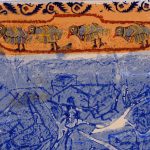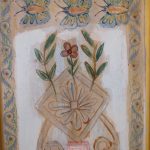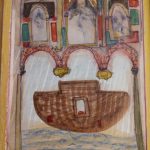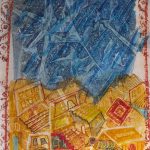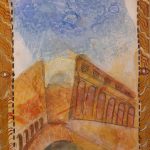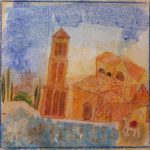Le opere dell’artista Jean Louis Poveda “L’HISTOIRE FLOTTANTE DE NOE’”presenti nel cuore del ghetto ebraico di Venezia trattano “La storia galleggiante di Noè” una serie di dipinti creati a seguito di Acqua Alta di un giorno nell’inverno del 2016.
Sulla Fondamenta della Misericordia, un bambino mette una barchetta di carta nell’acqua e si piega. Un grido materno suona “Noè Noè”. Questa voce fa rivivere bruscamente la fantasia del diluvio e l’epopea di Noè. Appaiono quindi gli animali a bordo della piccola barca.
Per quaranta giorni ha piovuto continuamente ed è stata desolazione. Per centocinquanta giorni, il pittore e Noè vagarono su un mare di segni e simboli prima di intravedere i colori. Infine, è l’abbondanza di luce e il cerchio cromatico di un arcobaleno che ha annunciato la rinascita di un mondo.
La colomba tornò con un ramoscello d’ulivo. Gli animali si sono metamorfosi.
Jean GIONO scrive nel suo “Noè”
Non c’era un’arca.
Ma no.
Non c’era una barca.
Né di cento, né di trecento, né di mille cubiti,
né di cento o trecento o mille falcate;
né di qualsiasi materiale misurabile
C’era il cuore
di Noè,
Né più né meno.
Come c’è il cuore
di ogni uomo.
Né più né meno.
E ho detto a Noè,
come posso dire a ogni uomo:
fa’entrare nel tuo cuore
tutta la carne
che c’è nel mondo
per tenerla in vita
con te.
Nei dipinti “alla tempera” le cui trasparenze illuminano il blu e gli ocra che ricordano l’iconografia bizantina, Jean Louis POVEDA racconta “Noè” con semplici immagini di coccinelle o cavallette, libellule o rinoceronti, tutti i rifugiati dell’Arca. Sono la metafora poetica dell’Altro accolto nei nostri cuori in modo che l’alterità possa entrare in noi.
Gabrielle TESTA
Présentée au cœur du ghetto juif de Venise «L’histoire flottante de Noé » est une série de peintures surgie des eaux un jour d’Acqua Alta de l’hiver 2016. Sur la Fondamenta della Misericordia, un petit garçon met un bateau en papier à l’eau et se penche. Un cri maternel retentit « Noé Noé ». Cette voix ravive brusquement le phantasme du déluge et l’épopée de Noé. Apparaissent alors les animaux embarqués dans le petit bateau.
Pendant quarante jours il a plu sans discontinuer et ce fut la désolation. Pendant cent cinquante jours le peintre et Noé errèrent sur une mer de signes et de symboles avant d’entrevoir les couleurs. Ce fut enfin le foisonnement de lumière et le cercle chromatique d’un arc en ciel qui annoncèrent la renaissance d’un monde. La colombe revint avec un rameau d’olivier. Les animaux se métamorphosèrent.
Jean GIONO écrit en exergue de son « Noé »
« Il n’y avait pas d’arche.
Mais non !
Il n’y avait pas de bateau
De cent, de trois cents ou de mille coudées,
d’aucune mesure matérielle.
Il y avait le cœur
de Noé.
Un point, c’est tout.
Comme il y a le cœur
de tout homme,
un point, c’est tout
Et j’ai dit à Noé
– comme je peux le dire
à tout homme :
– Fais entrer dans ton
cœur toute chair de
ce qui est au monde
pour le conserver en vie
avec toi »
Dans ses peintures « alla tempera » dont les transparences illuminent les bleus et les ocres, réminiscences de l’iconographie byzantine, Jean Louis POVEDA raconte « Noé » avec des images simples de coccinelles ou sauterelles, de libellules ou rhinocéros, tous réfugiés dans l’arche. Elles sont la métaphore poétique de l’Autre accueilli dans nos cœurs pour qu’en nous entre l’altérité.
Gabrielle TESTA
“The floating history of Noah” a series of works exhibited in the heart of the Jewish ghetto of Venice, is a set of tempera paintings created after an “Acqua Alta” occurred on a winter day in 2016.
On the Foundamenta della Misericordia, a child puts a small paper boat on the water and bends over. A maternal shout is heard “Noah, Noah!”. This voice revives suddenly the fantasy of the flood and the epic of Noah. Then appear the animals on board of the small boat.
For forty days it rained continually and it was desolation. For one hundred and fifty days the painter and Noah wandered on a sea made of signs and symbols before glimpsing the colors. At the end the abundance of light and the chromatic circle of a rainbow announced the rebirth of a world.
The dove returned with an olive branch. The animals metamorphosed.
Jean GIONO writes in his “Noé”
There wasn’t an ark.
No.
There wasn’t a boat.
Neither of an hundred, nor of three hundred, nor of a thousand cubits,
nor of any material measure
There was the heart
of Noah,
Neither more nor less.
Like there is every man’s heart,
Neither more nor less.
And I said to Noah,
As I could say to every man:
Bring into your heart
All the flesh
Which is in the world
to keep it alive
with you.
In his canvasses created with “tempera” whose transparencies illuminate the blues and ochres and recall the Byzantine iconography, Jean Louis Poveda tells “Noah” with simple images of ladybirds or grasshoppers, dragonflies or rhinos, all refugees in the Ark. They are the poetic metaphor of the Other welcomed into our hearts so that the otherness enters into everyone of us.
Gabrielle TESTA
L’artista, con la sua visione scenografica presenta una Venezia caratterizzata da una forza tra cultura, luce e vestigia. Le opere, dipinte a tempera, sono immagini poetiche e suggestioni astratte di Venezia, rappresentazioni parzialmente o totalmente immaginarie conosciute con il nome di vedute ideate o capricci secondo l’espressione vasariana.
Jean Louis Poveda è nato nel 1947 a Mascara, in Africa del Nord.
Dopo aver frequentato la Scuola di Belle Arti di Montpellier e parallelamente alla sua carriera nel cinema e al lavoro come scenografo, ha consacrato la maggior parte del suo tempo alla pittura e all’incisione, spostandosi tra Parigi, Montpellier e il mar Egeo.
La sua pittura attinge la forza che la caratterizza da Venezia e dai numerosi viaggi in barca nell’est del Mediterraneo fra cultura, luce e vestigia. E’ il frutto dell’incontro di due mondi : l’immaginario mediterraneo e la poetica del mondo orientale.
The artist, with his scenographic vision presents a Venice characterized by a strength between culture, light and vestiges. The works, painted in tempera, are poetic images and abstract suggestions of Venice, partially or totally imaginary representations known as conceived views or whims according to the Vasarian expression.
The French artist Jean Louis Poveda was born in Mascara, North Africa in 1947 and the land of his childhood – both this Mediterranean birthplace and the Sahara desert – have had a profound influence on his work.
Since graduating from the Montpellier School of Fine Arts, he has devoted much of his time – along with a cinéma career in scenography and production design – to painting and incision.
Living between Paris, Montpellier and the Aegean Sea, his painting was given renewed impetus during the course of his boat trips along the east Mediterranean. Amidst this rich culture, light and suggestion, his work came to incorporate the fruit of the intersection of two worlds: Mediterranean imagery and the poetics of the East.
